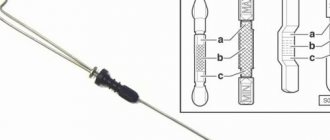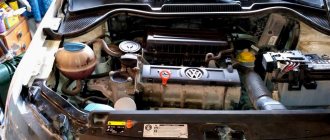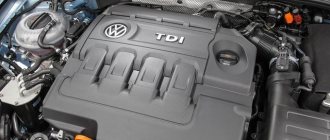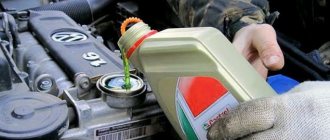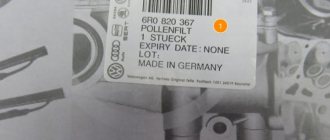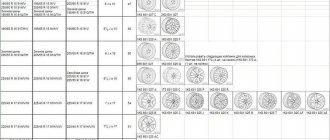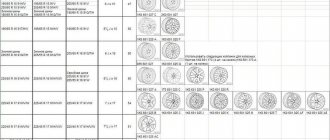Oil filter Polo 612 CFNA CFNB
Original part number 03C 115 561 H. Obsolete part number 03C 115 561 D. Best quality choice - Mann W 712/94.
Made in Germany. It is a complete analogue of the original conveyor belt. Knecht Mahle Austria OC 593/3 is made in China and costs the same as Mann.
Other analogues: Bosch F 026 407 116, Purflux France LS391, Filtron Poland OP 641/2. Polo pan plug (bolt) A single part with an O-ring. Actually, a piece of metal that is difficult to break.
The ring is also ordinary, steel. Bolt dimensions: thread M14 x 1.5 x 22, wrench 18.
Non-originals: Hans Pries Topran 109 035 785, Febi 15374, Swag 32915374, Elring 567. 640, Corteco 220125S, Dello 10N908013202 130016310.
Engine capacity, cc of competitors
| Automobile | Equipment | Engine capacity, cc | |
| Ford Fiesta | 1.1 MT Cool&Connect | 1084 | Look |
| Nissan Micra | 1.5 MT 89 hp | 1461 | Look |
| Honda Jazz | 1.3MT Comfort | 1317 | Look |
| Peugeot 208 | 1.2 PureTech MT | 1199 | Look |
Replacement, procedure for working tools
The generator is located directly below the filter. It's better to throw a rag over it so as not to get it dirty. Loosen the oil filter.
Let the oil drain into the pan for a while. The less of it remains, the less it will spill onto the rag or the belt with the generator, if the rag is not placed under it.
If the oil filter does not come off, a puller may be needed. Belt, chain or crab doesn't matter. If you want to use a cup, you will need a size of 74 mm.
and 12 faces. Auto stores sell inexpensive Chinese Avtodelo 40523 with a 1/2″ wrench and Russian Autom-2 with a nut welded to the cup. Both options are quite high quality.
The size of the key for the Volkswagen Polo drain plug is 1.6 - 18 mm. The tightening torque of the oil filter is 20–22 Nm.
The number of revolutions is not specified. Will I have to use a torque wrench?
The tightening torque for the drain plug is 35 Nm. Do not forget to lubricate the rubber filter ring with oil and test run the engine.
1.2 l, 105 hp, gasoline, robot, front-wheel drive, 2009 – 2014
- Trims: 1.2 TSI DSG Comfortline 3dr., 1.2 TSI DSG Comfortline 5dr.
- Engine: CBZB
| Engine oil volume | SAE classification | Replacement interval | Engine oil |
| 3.8 l | 5W-30, 5W-40 | 15000 km / 12 months | Volkswagen Special Plus 5w40 |
Additional Information
- Oil type: synthetic
- Manufacturer approval: VW 502.00
- Oil filter (part number): 03C115561H
1.2 l, 60 hp, gasoline, manual transmission, front-wheel drive, 2009 – 2014
- Options: 1.2 Trendline 3dr., 1.2 Trendline 5dr.
- Engine: CGPB
| Engine oil volume | SAE classification | Replacement interval | Engine oil |
| 2.8 l | 0W-30 | 15000 km / 12 months |
Additional Information
1.2 l, 70 hp, gasoline, manual transmission, front-wheel drive, 2009 – 2014
- Options: 1.2 JOY 5dr., 1.2 Trendline 3dr., 1.2 Trendline 5dr.
- Engine: CGPA
| Engine oil volume | SAE classification | Replacement interval | Engine oil |
| 2.8 l | 0W-30 | 15000 km / 12 months |
1.4 l, 125 hp, gasoline, front-wheel drive, manual transmission/robot, 2016 – present. vr.
- Trims: 1.4 TSI MT Drive, 1.4 TSI MT GT, 1.4 TSI MT Highline, 1.4 TSI DSG Drive, 1.4 TSI DSG GT, 1.4 TSI DSG Highline
- Engine: CZCA
| Engine oil volume | SAE classification | Replacement interval | Engine oil |
| 4.0 l | 5W-30, 5W-40 | 15000 km / 12 months | Castrol EDGE Professional LongLife III |
- Oil type: synthetic
- Manufacturer approval: VW 504.00, 502.00
- Oil filter (article): VAG 04E115561H
1.4 l, 85 hp, gasoline, front-wheel drive, manual transmission/robot, 2009 – 2014
- Configurations: 1.4 JOY 5dr., 1.4 Style 5dr., 1.4 Comfortline 3dr., 1.4 Comfortline 5dr., 1.4 Trendline 3dr., 1.4 Trendline 5dr., 1.4 DSG JOY 5dr., 1.4 DSG CrossPolo 5dr., 1.4 DSG Style 5dr., 1.4 DSG Comfortline 3dr., 1.4 DSG Comfortline 5dr., 1.4 DSG Trendline 3dr., 1.4 DSG Trendline 5dr.
- Engine: CDDA, CLPA, CGGB
| Engine oil volume | SAE classification | Replacement interval | Engine oil |
| 3.2 l | 5W-30 | 15000 km / 12 months |
1.6 l, 105 hp, gasoline, front-wheel drive, manual transmission/automatic transmission, 2010 – 2015
- Trims: 1.6 MPI MT Club, 1.6 MPI MT Style, 1.6 MPI MT Sochi Edition, 1.6 MPI MT Comfortline, 1.6 MPI MT Highline, 1.6 MPI MT Trendline, 1.6 MPI AT Club, 1.6 MPI Tiptronic Style, 1.6 MPI Tiptronic Sochi Edition, 1.6 MPI Tiptronic Comfortline, 1.6 MPI Tiptronic Highline, 1.6 MPI Tiptronic Trendline, 1.6 MPI AT Highline, 1.6 MPI AT Comfortline
- Engine: CLSA, CFNA
| Engine oil volume | SAE classification | Replacement interval | Engine oil |
| 3.6 l | 5W-30, 5W-40 | 15000 km / 12 months |
Additional Information
- Oil type: synthetic
- Manufacturer approval: VW 502/505
- Oil filter (article): 03C115561D or 03C115561H
1.6 l, 110 hp, gasoline, front-wheel drive, manual transmission/automatic transmission, 2015 – present. vr.
- Trims: 1.6 MPI MT Drive, 1.6 MPI MT Life, 1.6 MPI MT Allstar, 1.6 MPI MT Highline, 1.6 MPI MT Comfortline, 1.6 MPI MT Trendline, 1.6 MPI AT Drive, 1.6 MPI AT Life, 1.6 MPI AT Allstar, 1.6 MPI AT Comfortline, 1.6 MPI AT Highline, 1.6 MPI AT Trendline
- Engine: CWVA
| Engine oil volume | SAE classification | Replacement interval | Engine oil |
| 4.2 l | 5W-30, 5W-40 | 15000 km / 12 months |
Additional Information
- Oil type: synthetic
- Manufacturer approval: VW 502 00 / 505 00
- Oil filter (article): VAG 04E115561H
1.6 l, 85 hp, gasoline, front-wheel drive, manual transmission, 2014 – 2015
- Trims: 1.6 MPI MT Club, 1.6 MPI MT Conceptline, 1.6 MPI MT Comfortline, 1.6 MPI MT Trendline, 1.6 MPI MT Style, 1.6 MPI MT Comfortline
- Engine: CFNB
| Engine oil volume | SAE classification | Replacement interval | Engine oil |
| 3.6 l | 5W-30, 5W-40 | 15000 km / 12 months |
Additional Information
- Oil type: synthetic
- Manufacturer approval: VW 502 00/505 00
- Oil filter (article): 03C115561D or 03C115561H
1.6 l, 90 hp, gasoline, manual transmission, front-wheel drive, 2015 – present. vr.
- Trims: 1.6 MPI MT Drive, 1.6 MPI MT Life, 1.6 MPI MT Allstar, 1.6 MPI MT Comfortline, 1.6 MPI MT Conceptline, 1.6 MPI MT Trendline
- Engine: CFW
| Engine oil volume | SAE classification | Replacement interval | Engine oil |
| 3.6 l | 5W-30, 5W-40 | 15000 km / 12 months |
Additional Information
- Oil type: synthetic
- Manufacturer approval: VW 502 00
– the service oil volume is indicated. – when operating a vehicle in difficult conditions (high load, harsh environmental conditions, low quality fuel, city traffic jams and short trips), it is recommended to reduce the engine oil change interval by 2 times.
Volkswagen polo sedan engine, technical characteristics of volkswagen polo engines
The Volkswagen Polo sedan engine, which we will talk about today, will be produced directly in Russia in 2022, at the new Volkswagen engine plant. True, the timing chain will be replaced with a belt, and the power of the unit will increase by 5 horsepower.
In addition to the Polo sedan, a 1.6-liter gasoline engine is now installed in the larger Jetta, Skoda Octavia and Rapid models. The 1.6-liter power unit, the most popular among our customers, is produced in two versions with a capacity of 85 and 105 hp.
with 16 valves (factory designation CFNB and CFNA, respectively). The difference between the 85 horsepower version and the 105 horsepower modification of the Volkswagen Polo engine lies in the design features of the cylinder head and the presence (or absence) of a variable valve timing system.
Naturally, due to the presence of a timing system, the 105 strong version is more powerful, dynamic and economical. First, let's talk about the more powerful Polo sedan engine. So, the Polo 1.6 16V engine has the factory name CFNA. It is a gasoline, four-stroke, 4-cylinder, in-line, 16-valve, two-camshaft engine. Under the hood it stands transversely. The operating order of the cylinders is: 1-3-4-2, counting from the crankshaft pulley.
The engine power supply system of the Volkswagen Polo sedan is phased distributed fuel injection. The engine is mounted on three elastic rubber-metal supports.
The right support is hydraulic; it is attached to a bracket attached to the timing cover, and the left and rear engine mounts are attached to brackets on the gearbox housing. The Volkswagen Polo engine cylinder block is aluminum, the cylinder head is also aluminum, and the engine sump is also made made of aluminum alloy.
In the 16-valve version, the spark plugs are screwed into the top center of the combustion chamber. Timing chain drive. The chain in the engine makes the Polo sedan 1.6 unit very reliable and durable. In addition, the cylinder head contains hydraulic compensators that automatically regulate the thermal clearance of the valves. The engine is very sensitive to oil quality.
Underfilling of oil and its reduced level can lead to rapid wear of the hydraulic compensators.
The Polo sedan 1.6 engine has a system of continuously variable valve timing of the intake valves, which makes the engine flexible in all operating ranges. The engine has a contactless ignition system with four coils. The entire operation of the power unit is controlled by an electronic control unit (the brains of the motor).
An electronic system controls fuel distribution. The dosed working mixture is supplied to the cylinders through the throttle assembly in accordance with the valve timing. Below are detailed characteristics of the Volkswagen Polo 1.6 16V CFNA engine.
Regulations
To choose the right oil, you need to act step by step and observe all important parameters, including performance indicators. For example, you need to know when to replace consumables. For this, the manufacturer has developed a replacement schedule, which for the VW Polo Sedan is about 20 thousand kilometers.
This is a conditional indicator that can be changed at the insistence of the dealership, or on the initiative of the owner himself (with self-service). In the latter case, changing the oil is much more difficult, but it is a very educational and economical procedure that does not take much time. It will have to be carried out as often as possible if the machine is operated in unstable climatic zones and is subjected to high loads.
After all, under the influence of negative factors, the oil must be changed in advance so that it does not have time to lose its properties. Due to difficult conditions, the regulations can be reduced to 10 thousand kilometers. In addition, rapid oil wear is affected by high speed, driving on light off-road conditions, including dusty roads, constant temperature changes, sudden maneuvers and even traffic violations.
In such cases, you must be prepared to change the oil earlier than required by the regulations. But for this it is important to know several factors.
When to check the oil condition
Many people check the condition of the oil according to regulations. In fact, it is better to do this earlier, without waiting for the regulations. The following signs indicate problems with oil:
- Insufficient engine power
- Increased fuel consumption
- Increased oil consumption
- Possible delays and jerks when changing gears
- Excessive noise and vibration levels
If these deviations are detected, it would be a good idea to check the condition of the oil.
Oil parameters
Naturally, for Volkswagen Polo it is better to select oil from a well-known manufacturer. Brands with a dubious reputation should be immediately avoided. In order not to get confused in the choice, you must proceed from the recommended parameters developed by the Volkswagen concern itself. For example, first of all, one must proceed from the viscosity characteristics of SAE 5W-40 and 5W-30, as well as the international standards ACEA A2 and ACEA A3. In addition, you need to pay attention to compliance with markings 501 01, 502 00 and 503 00.
The original oil, as well as its analogues, have these parameters. To date, the production of analogues has been established in Germany, Russia, Romania, Moldova, China and other countries. The quality of these oils has recently become equal to more expensive original oils.
Based on this, the obvious choice is in favor of an analogue oil. Although many still prefer the original product.
Among the best manufacturers of motor oils for Volkswagen Polo are the brands Castrol, Mobile, Lukoil, Elf, Kixx and other well-known companies with a good reputation. Also, owners often prefer Shell Helix Ultra motor oil.
Types of motor oils
At the end of the article, we will look at what types of motor oils there are. There are only three of them.
- Synthetic is the best motor oil today. It has good fluidity properties, and also has excellent non-stick and antioxidant properties, and is not afraid of frost and sudden temperature changes. Recommended for modern cars with low mileage. The main disadvantage of oil is its high cost due to the listed advantages.
- Mineral is the cheapest motor oil; it is often used as a technical fluid for flushing the engine from old oil residues, metal shavings and other deposits. It should not be poured into the Volkswagen Polo engine, especially with low mileage. In addition, mineral water should not be used at low temperatures. The fact is that this is a thicker oil that is prone to solidification.
- Semi-synthetic is a worthy option to replace mineral oil. It has optimal advantages for its price. It moderately resists low temperatures and has a longer lifespan than the mineral composition. And yet, semi-synthetics cannot completely replace pure synthetics, and they should be used only in extreme cases.
- We can conclude that the first place for Volkswagen is any synthetic oil - either original or a well-known analogue. It is better to use semi-synthetics for high mileage, and it is not recommended to fill in mineral oil.
Vw polo sedan 1.6 110 hp (cwva)
We begin the draining procedure:
- Raise the hood, then find the filler neck on the engine and unscrew the plug (Fig. 6). Fig.6 Oil filler neck
- Now we go down under the car and place a waste container in the drainage area. You can use a cut canister or an old bucket.
- We unscrew the drain plug with a wrench or a 18 or 19 socket, depending on its type (Fig. 7). Fig.7 Drain plug
- Now you need to remove the old oil filter. This can be done from above, from the engine compartment (Fig. 8). Fig.8 Oil filter on top
- The filter is clearly visible from above, but unscrewing it is not so convenient, so we do it from below. Access is very good, nothing interferes (Fig. 9). Fig.9 Oil filter from below
- On this engine the drain plug is also located, not at the lowest point. Therefore, you can use a syringe with a tube. To pump out the remaining waste, as shown in Figure 5.
To unscrew the filter element, it is advisable to have a special puller. If it is not available, you can try to unscrew the filter using improvised means. In this case, you can use, for example, an old alternator belt, a regular belt, a bicycle chain or a simple screwdriver.
Unscrewing the oil filter using improvised means
Using this method, you can drain the maximum amount of used oil, after which you can proceed to further actions. The main thing is not to forget, everything that we unscrewed must be put back in place.
